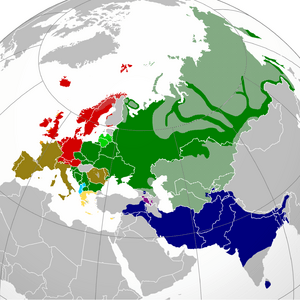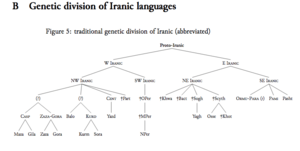Indo-Iranian languages facts for kids
Quick facts for kids Indo-Iranian |
|
|---|---|
| Aryan | |
| Geographic distribution: |
Eastern Europe, Western Asia, South Asia |
| Linguistic classification: | Indo-European
|
| Proto-language: | Proto-Indo-Iranian |
| Subdivisions: |
Iranian
|
| ISO 639-5: | iir |
 The general location of Indo-European speakers in Europe and Asia. Indo-Iranian
|
|
The Indo-Iranian languages are a big group of languages that belong to the even larger Indo-European language family. Think of it like a big tree, and Indo-Iranian is one of its main branches. This group includes two major parts: the Indo-Aryan (also called Indic) languages and the Iranic (or Iranian) languages.
Most of these languages are spoken in the Indian subcontinent and the Iranian plateau. A long time ago, people who spoke these languages lived in Central Asia, which is east of the Caspian Sea.
Contents
Indo-Aryan Languages: A Big Family
- Further information: Indo-Aryan languages
There are about 221 different Indo-Aryan (or Indic) languages. More than 800 million people speak them! That's a lot of speakers.
Here are some of the most widely spoken Indo-Aryan languages:
- Bengali: This is the official language in Bangladesh. It's also an official language in some parts of India.
- Marathi: This is an official language in certain regions of India.
- Hindustani: This language has two main forms. One is Urdu, which is an official language in Pakistan. The other is Hindi, which is an official language in India.
Iranian Languages: Spoken Across Asia
There are about 86 Iranian languages. Between 150 and 200 million people speak them around the world.
Here are some of the most common Iranian languages:
- Persian: This is the official language in Iran. It's also official in Afghanistan (where it's called Dari) and in Tajikistan (where it's called Tajik).
- Pashto: This is an official language in Afghanistan.
- Kurdish: This language is official in the Kurdistan Region of Iraq.
Nuristani, Bangani, and Badeshi Languages
- Further information: Nuristani languages and Badeshi language
Some experts think that the Nuristani and Bangani languages are part of the Indo-Aryan group. However, other experts believe they are their own separate groups within Indo-Iranian. The Badeshi language is another Indo-Iranian language that hasn't been fully classified yet.
Images for kids
See also
 In Spanish: Lenguas indoiranias para niños
In Spanish: Lenguas indoiranias para niños



